Enantioselective synthesis of 3-arylindole atropisomers via organocatalytic indolization of iminoquinones
Abstract
The direct enantioselective construction of axially chiral 3-arylindole frameworks via nucleophilic addition of 2-substituted indoles to iminoquinones has been achieved with high efficiencies under mild chiral phosphoric acid (CPA) catalytic conditions. The utility of this method was demonstrated in successful scale-up syntheses without compromising the product yields and enantioselectivities. The oxidation of products yields axially chiral heteroaryl-p-quinone monoimine, which could be subjected to structural diversification via addition of nucleophiles.
Keywords
INTRODUCTION
Indole-based compounds are an important class of small organic molecules. They are broadly present as core structural components in bioactive natural products, organic functional materials and pesticides[1-4]. As one of the prominent subclass, axially chiral 3-arylindole and its derivatives are valuable candidates used to derive bioactive molecules[5-8] and chiral catalysts [Scheme 1A][9]. In line with the progression of axial chirality chemistry, the design and synthesis of axially chiral 3-arylindole frameworks have also emerged recently[10]. Organocatalysis proved to be a useful synthetic tool and has unlocked strategies that range from atroposelective functionalization of preformed arylindole scaffolds[11-13] to direct arylation of indoles[14-19] and heteroarene formation[20-22]. The pioneering work in catalytic asymmetric construction of axially chiral arylindoles came from Zhang et al.[19], who achieved atroposelective arylation of 2-naphthols or phenols with C3-electrophilic 2-indolylmethanols in the presence of chiral phosphoric acid (CPA) catalyst. In 2019, He et al.[21] prepared axially chiral 3-pyrrolylindole skeletons with asymmetric Barton-Zard reaction, following a sequence of pyrrole ring construction and central-to-axial chirality conversion. Differently, Lu et al.[22] successfully synthesized the axially chiral bridged C3-arylindoles through an ingenious cascade reaction between propargylic alcohols and enals by employing chiral N-heterocyclic carbene catalyst.
Scheme 1. The applications of representative molecules containing C3-arylindole framework and our designed strategy for their asymmetric synthesis. (A) Bioactive molecules and chiral catalysts containing C3-arylindole scaffolds; (B) the asymmetric construction of biaryl aminoalcohols using iminoquinones reported by our group; (C) our strategy for organocatalytic enantioselective synthesis of 3-arylindole atropisomers with iminoquinones.
Although these strategies represent significant advances in the asymmetric synthesis of axially chiral indole compounds, more efficient synthetic methodologies are highly anticipated to enhance their availability and further accelerate their development and applications[10]. In particular, methods that could directly construct and define the configuration of stereogenic axis would enable modular assembly of these useful scaffolds. Our ongoing research on atroposelective organocatalytic arylation reactions has established the use of iminoquinone and its derivatives as arene precursors, which could undergo addition with different arene nucleophiles[23-25]. As an illustration, a CPA-catalyzed direct arylation of 2-naphthylamine with iminoquinones as electrophiles could accomplish the asymmetric construction of axially chiral biaryl aminoalcohols [Scheme 1B][24]. In light of these preceding studies and the verified use of iminoquinones in the synthesis of axially chiral scaffolds, we envisioned the assembly of new axially chiral 3-arylindole framework through the asymmetric coupling of indoles with iminoquinones, as shown in Scheme 1C.
Although the reaction is conceptually feasible, substantial challenges could lie in achieving the enantioselective construction of this framework. In contrast with prior studies that employ iminoquinone substrates to generate six-membered (hetero)biaryls, the lower rotational barrier of five-membered 3-arylindole scaffolds might promote racemization and compromises the reaction enantioselectivity. The configuration stability of such scaffolds is typically lower than the six-membered (hetero)biaryl atropisomers[26,27]. To impede the free rotation around the newly formed C-C axis, we sought to amplify the steric effect at the iminoquinone moiety or at the C2-position of indoles. On the other hand, the presence of multiple reactive sites on both reacting substrates could interfere with the control of regio- and enantioselectivity in the synthesis of 3-arylindole atropismers 3. In this regard, a suitable bifunctional organocatalyst such as chiral phosphoric acid (CPA) should overcome the substrate-imposed selectivity bias, thereby providing exquisite chemo- and stereoselectivity control during the C-C bond formation. In addition, the N-protecting groups of iminoquinones could be a useful tuning parameter to modulate selectivities.
EXPERIMENTAL
Chiral phosphoric acid (R)-C6 (5 mol%), 1 (0.28 mmol) and 2 (0.20 mmol) were added to a Schlenk tube, then 4 mL of 1,2,4-trichlorobenzene was added via syringe in one portion. Upon the completion of the reaction (about 1 h), the mixture was purified by preparative TLC (CH2Cl2/PE = 5/1 to 6/1) to give the pure products 3.
RESULTS AND DISCUSSION
To validate the approach, we initiated exploration with N-benzoyl iminoquinone 1a and 2-(tert-butyl)-1H-indole 2a as the model nucleophile in view of its good nucleophilicity. The large steric hindrance at C2-position was expected to stabilize the newly formed chiral axis. Different chiral phosphoric acids were first evaluated and all were found to smoothly promote the model reaction to afford axially chiral product 3a at room temperature (see Supplementary Materials for details). This screening revealed (R)-C6 to afford the best overall product yield and enantioselectivity. Other solvents were subsequently investigated based on (R)-C6 as the optimal catalyst. The discovery that toluene could deliver better enantioselectivity than dichloromethane and 1,2-dichloroethane led us to screen a series of benzene-derived solvents. 1,2,4-trichlorobenzene was thus chosen as the reaction solvent due to its best performance. Having noticed that further fine-tuning of other parameters did not improve the results (3a, 88% yield, 78% ee, Scheme 2), we turned to modulating the N-protecting group of iminoquinones for a breakthrough. As shown in Scheme 2, we were delighted to find that the replacement of H atom by Cl atom at C2-position on the benzoyl group would enhance the product ee to 86% (3b). When the C2 and C6 positions were occupied by Cl and Br substituents respectively, product 3c could be derived with 94% ee under the same conditions (see Supplementary Materials for details). The dramatic decrease of yield and ee value (3d, 34%, 33% ee) observed for 1d suggested the great influence that the iminoquinone substituents have had on the reaction.
The substrate generality of iminoquinones was then systematically examined under optimal reaction conditions. As shown in Scheme 3, all of the tested iminoquinones reacted smoothly with 2a to afford the corresponding products with moderate to high efficiencies (up to 94% yield and 94% ee). Notably, different aromatic substituents and substitution positions on the benzoyl group were tolerated. Overall, various halogen atoms (F, Cl, Br, I) or Me group could be incorporated as the C2 and C4 substituents without significant influence on the reaction outcomes. The benzoyl group could also bear 2,4,6-trisubstitution with Cl or Me groups to afford 3m and 3n in good results. Nonetheless, slightly inferior enantioselectivities (84%-87% ee) could be seen for substrates with methyl substitutions (3g and 3n) or with methoxy group (3j).
Inspired by the above results, we then turned our attention to investigating the generality of indole substrates [Scheme 4]. From the selected examples (3p, 3s, 3t and 3u), it could be recognized that the electronic properties of the indole substituents presented limited impact on the product yields and enantioselectivities. However, a more pronounced structural variation of substrates such as disubstitution (3v) and an additional fused ring (3w) could negatively affect the product yields. As expected, 2-(tert-pentyl)-1H-indole and 2-(1-adamantyl)-1H-indole were also effective nucleophiles to give the corresponding products 3x and 3y. Our method thus represents one of the most straightforward ways to access axially chiral C3-arylindoles. The absolute configuration of the product 3s was confirmed by X-ray crystallography (CCDC: 2225458) and the stereochemistry of other products has been assigned by analogy.
To further demonstrate the utility of this strategy, the scale-up synthesis of 3c and a series of chemical transformations were conducted. First, the gram-scale reaction could deliver product 3c with nearly the same yield (87%) and enantioselectivity (93% ee) as the small-scale reaction [Scheme 5A]. The oxidative treatment of compound 3c with Ag2O gave the atropisomeric heteroaryl-p-quinone monoimine 4c in 90% yield without any erosion of enantioselectivity [Scheme 5B]. The unsaturated nature of this novel axially chiral heteroaryl-p-quinone monoimine compound sets the stage for nucleophilic addition: With indoles as the representative C-nucleophiles, products 5c-1 and 5c-2 that display both axial and central chirality could be accessed in the presence of phosphoric acid catalyst rac-C6. The absolute configuration of 5c-1 (CCDC: 2226266) was unambiguously assigned by single-crystal X-ray diffraction analysis [Scheme 5C]. Next, the methoxy group of 3s could be readily deprotected by BBr3 in CH2Cl2 to yield compound 4s, which should serve as useful skeleton to design chiral catalysts and ligands [Scheme 5D].
Scheme 5. Gram-scale reaction and derivatization of C3-arylindole products. (A) Gram-scale synthesis of 3c; (B) oxidation reaction of 3c; (C) nucleophilic addition of indoles with 4c; (D) demethylation reaction of 3s.
Based on the experimental results and reported literature[23,24], a plausible reaction mechanism with representative substrates was put forward, as illustrated in Scheme 6. At the beginning of reaction, CPA catalyst simultaneously activates 1c and 2a through a bifunctional H-bonding activation mode (C). Subsequently, a stereoselective coupling proceeds and gives rise to adduct M with well-defined contiguous chiral centers. Rearomatization of product M under standard conditions is accompanied by efficient central-to-axial chirality conversion to give the final product 3c.
CONCLUSIONS
In summary, the enantioselective construction of 3-arylindole atropisomers was efficiently accomplished by organocatalytic indolization of iminoquinones in the presence of CPA catalyst. The conditions were proven to be scalable and various downstream synthetic transformations demonstrated the utilities of this strategy. The oxidation of the obtained products furnished a novel axially chiral heteroaryl-p-quinone monoamine compound, which could serve as an enantioenriched precursor to construct functionalized axially chiral indoles via nucleophilic addition. Further exploration of this reactivity is underway in our laboratory.
DECLARATIONS
Authors’ contributions
Designing the experiments, writing the manuscript, and being responsible for the whole work: Tan B, Chen YH
Performing the experiments and synthesizing the substrates: Liu YW, Cheng JK, Xiang SH
Availability of data and materials
The X-ray crystallographic coordinates for the structure of 3s and 5c-1 reported in this article have been deposited at the Cambridge Crystallographic Data Centre (CCDC) under deposition numbers CCDC 2225458 and 2226266. These data can be obtained free of charge from The Cambridge Crystallographic Data Centre via http://www.ccdc.cam.ac.uk/data_request/cif. Experimental procedures and characterization of new compounds are available in the Supplementary Materials.
Financial support and sponsorship
We are grateful for financial support from the National Natural Science Foundation of China (21825105, 22231004 and 22271135), National Key R&D Program of China (2021YFF0701604), Guangdong Provincial Key Laboratory of Catalysis (2020B121201002), Guangdong Innovative Program (2019BT02Y335), and Shenzhen Science and Technology Program (KQTD20210811090112004, JCYJ20210324120205016, JCYJ20210324105005015). The authors appreciate the assistance of SUSTech Core Research Facilities.
Conflicts of interest
All authors declared that there are no conflicts of interest.
Ethical approval and consent to participate
Not applicable.
Consent for publication
Not applicable.
Copyright
© The Author(s) 2023.
Supplementary Materials
REFERENCES
1. Bandini M, Eichholzer A. Catalytic functionalization of indoles in a new dimension. Angew Chem Int Ed Engl 2009;48:9608-44.
2. Kochanowska-Karamyan AJ, Hamann MT. Marine indole alkaloids: potential new drug leads for the control of depression and anxiety. Chem Rev 2010;110:4489-97.
3. Wan Y, Li Y, Yan C, Yan M, Tang Z. Indole: a privileged scaffold for the design of anti-cancer agents. Eur J Med Chem 2019;183:111691-708.
5. Zhang HH, Shi F. Organocatalytic atroposelective synthesis of indole derivatives bearing axial chirality: strategies and applications. Acc Chem Res 2022;55:2562-80.
6. Anilkumar GN, Lesburg CA, Selyutin O, et al. I. Novel HCV NS5B polymerase inhibitors: discovery of indole 2-carboxylic acids with C3-heterocycles. Bioorg Med Chem Lett 2011;21:5336-41.
7. Luz JG, Carson MW, Condon B, et al. Indole glucocorticoid receptor antagonists active in a model of dyslipidemia act via a unique association with an agonist binding site. J Med Chem 2015;58:6607-18.
8. Sharma K, Baral ER, Akhtar MS, Lee YR, Kim SH, Wee YJ. 3-Naphthylindoles as new promising candidate antioxidant, antibacterial, and antibiofilm agents. Res Chem Intermed 2017;43:2387-99.
9. Jiang F, Luo GZ, Zhu ZQ, Wang CS, Mei GJ, Shi F. Application of naphthylindole-derived phosphines as organocatalysts in[4 + 1] cyclizations of o-quinone methides with Morita-Baylis-Hillman carbonates. J Org Chem 2018;83:10060-9.
10. Li TZ, Liu SJ, Tan W, Shi F. Catalytic asymmetric construction of axially chiral indole-based frameworks: an emerging area. Chem Eur J 2020;26:15779-92.
11. Jiang F, Chen KW, Wu P, Zhang YC, Jiao Y, Shi F. A strategy for synthesizing axially chiral naphthyl-indoles: catalytic asymmetric addition reactions of racemic substrates. Angew Chem Int Ed Engl 2019;58:15104-10.
12. Sheng FT, Li ZM, Zhang YZ, et al. Atroposelective synthesis of 3,3’-bisindoles bearing axial and central chirality: using isatin-derived imines as electrophiles. Chin J Chem 2020;38:583-9.
13. Chen KW, Wang ZS, Wu P, et al. Catalytic asymmetric synthesis of 3,3’-bisindoles bearing single axial chirality. J Org Chem 2020;85:10152-66.
14. Qi LW, Mao JH, Zhang J, Tan B. Organocatalytic asymmetric arylation of indoles enabled by azo groups. Nat Chem 2018;10:58-64.
15. Zhu S, Chen YH, Wang YB, et al. Organocatalytic atroposelective construction of axially chiral arylquinones. Nat Commun 2019;10:4268-77.
16. Lu DL, Chen YH, Xiang SH, Yu P, Tan B, Li S. Atroposelective construction of arylindoles by chiral phosphoric acid-catalyzed cross-coupling of indoles and quinones. Org Lett 2019;21:6000-4.
17. Ding WY, Yu P, An QJ, et al. DFT-guided phosphoric-acid-catalyzed atroposelective arene functionalization of nitrosonaphthalene. Chem 2020;6:2046-59.
18. Chen YH, Li HH, Zhang X, Xiang SH, Li S, Tan B. Organocatalytic enantioselective synthesis of atropisomeric aryl-. p ;59:11374-8.
19. Zhang HH, Wang CS, Li C, Mei GJ, Li Y, Shi F. Design and enantioselective construction of axially chiral naphthyl-indole skeletons. Angew Chem Int Ed Engl 2017;56:116-21.
20. Bisag GD, Pecorari D, Mazzanti A, et al. Central-to-axial chirality conversion approach designed on organocatalytic enantioselective povarov cycloadditions: First access to configurationally stable indole-quinoline atropisomers. Chem Eur J 2019;25:15694-701.
21. He XL, Zhao HR, Song X, Jiang B, Du W, Chen YC. Asymmetric Barton-Zard reaction to access 3-pyrrole-containing axially chiral skeletons. ACS Catal 2019;9:4374-81.
22. Lu S, Ong JY, Yang H, et al. Diastereo- and atroposelective synthesis of bridged biaryls bearing an eight-membered lactone through an organocatalytic cascade. J Am Chem Soc 2019;141:17062-7.
23. Zhang X, Chen YH, Tan B. Organocatalytic enantioselective transformations involving quinone derivatives as reaction partners. Tetrahedron Lett 2018;59:473-86.
24. Chen YH, Qi LW, Fang F, Tan B. Organocatalytic atroposelective arylation of 2-naphthylamines as a practical approach to axially chiral biaryl amino alcohols. Angew Chem Int Ed Engl 2017;56:16308-12.
25. Cheng JK, Xiang SH, Tan B. Organocatalytic enantioselective synthesis of axially chiral molecules: development of strategies and skeletons. Acc Chem Res 2022;55:2920-37.
26. Kumarasamy E, Raghunathan R, Sibi MP, Sivaguru J. Nonbiaryl and heterobiaryl atropisomers: molecular templates with promise for atropselective chemical transformations. Chem Rev 2015;115:11239-300.
Cite This Article
Export citation file: BibTeX | RIS
OAE Style
Liu YW, Chen YH, Cheng JK, Xiang SH, Tan B. Enantioselective synthesis of 3-arylindole atropisomers via organocatalytic indolization of iminoquinones. Chem Synth 2023;3:11. http://dx.doi.org/10.20517/cs.2022.46
AMA Style
Liu YW, Chen YH, Cheng JK, Xiang SH, Tan B. Enantioselective synthesis of 3-arylindole atropisomers via organocatalytic indolization of iminoquinones. Chemical Synthesis. 2023; 3(2): 11. http://dx.doi.org/10.20517/cs.2022.46
Chicago/Turabian Style
Liu, Yu-Wei, Ye-Hui Chen, Jun Kee Cheng, Shao-Hua Xiang, Bin Tan. 2023. "Enantioselective synthesis of 3-arylindole atropisomers via organocatalytic indolization of iminoquinones" Chemical Synthesis. 3, no.2: 11. http://dx.doi.org/10.20517/cs.2022.46
ACS Style
Liu, Y.W.; Chen Y.H.; Cheng JK.; Xiang S.H.; Tan B. Enantioselective synthesis of 3-arylindole atropisomers via organocatalytic indolization of iminoquinones. Chem. Synth. 2023, 3, 11. http://dx.doi.org/10.20517/cs.2022.46
About This Article
Special Issue
Copyright
Data & Comments
Data
 Cite This Article 38 clicks
Cite This Article 38 clicks


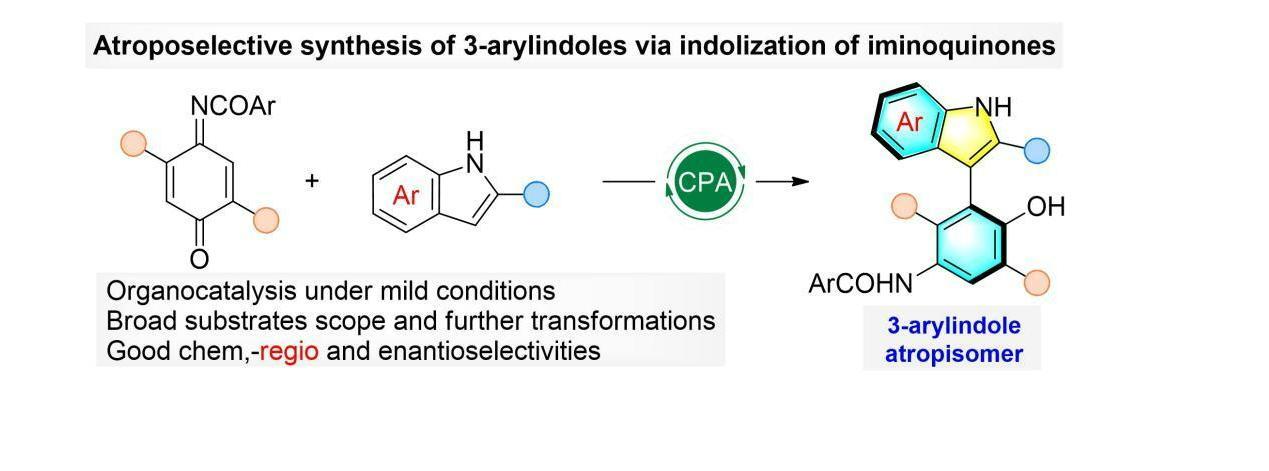

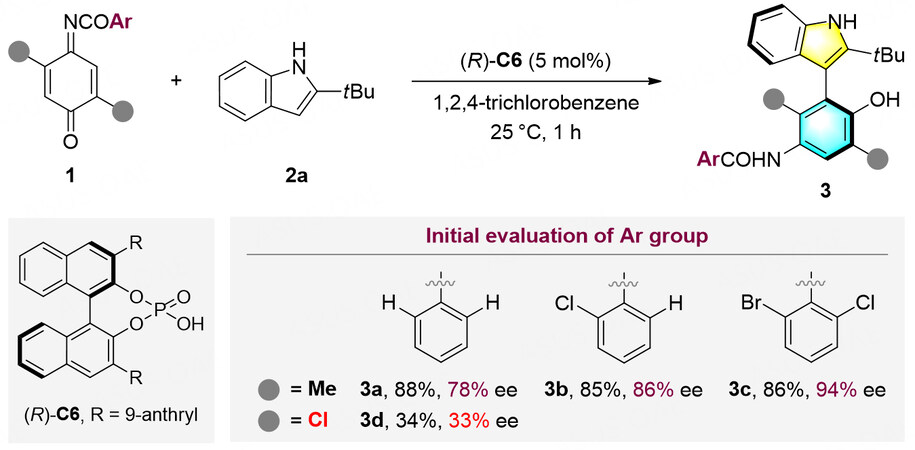
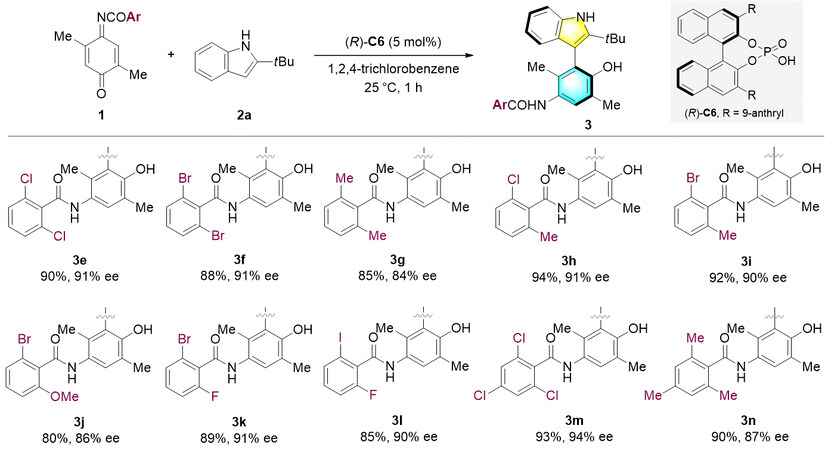
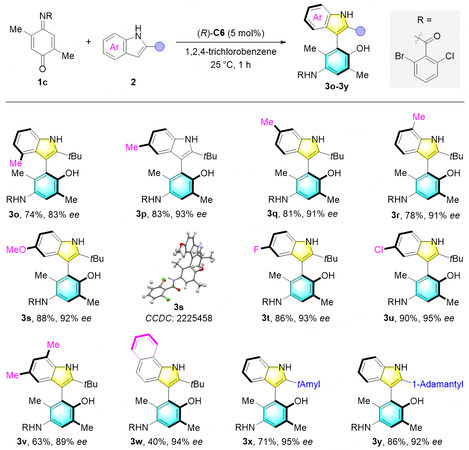
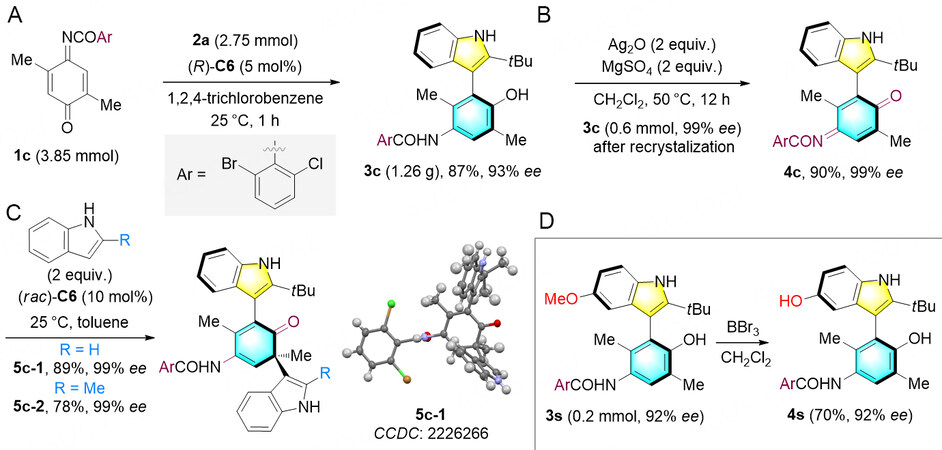
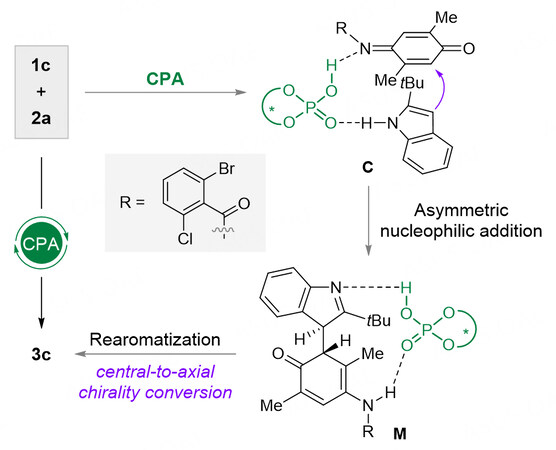











Comments
Comments must be written in English. Spam, offensive content, impersonation, and private information will not be permitted. If any comment is reported and identified as inappropriate content by OAE staff, the comment will be removed without notice. If you have any queries or need any help, please contact us at support@oaepublish.com.